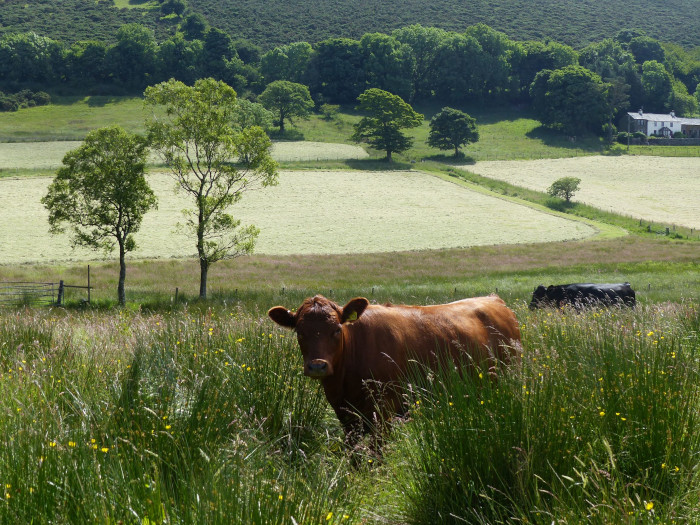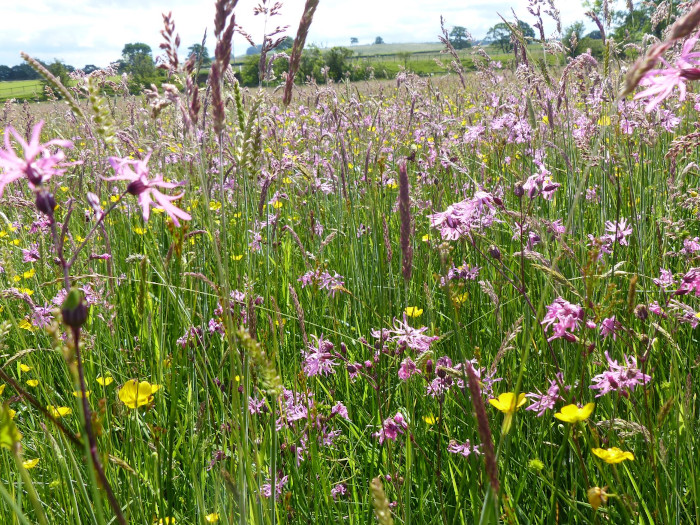Our Farm
Our farmland is in three separate blocks, all within two miles of the farmhouse. Each is quite different, reflecting its previous management, underlying soil, altitude, aspect and exposure.
 Dexter cattle with silage field behind.
Dexter cattle with silage field behind.
 Ragged-robin
Ragged-robin
Our Pastures
Containing a mix of grass species with herbs and wildflowers, many of our pastures have a good clover content too. Clover fixes atmospheric nitrogen, which is then available to sustain plant growth. By increasing the amount of clover in the sward we have been able to significantly reduce the amount of artificial fertiliser we need.
All our land is classified as Less Favoured Area in agricultural terms and we are designated as Severely Disadvantaged – mainly because our adverse climate and altitude mean we have a short growing season.
Farming WITH nature
As well as summer grazing and winter rations for our livestock our land provides a variety of natural habitats - woodlands, wetlands, ponds, hedges and non-grazed areas. Having created many of these ‘wild’ areas we invest time managing them to ensure that they continue to provide ample feed and shelter for indigenous flora and fauna.
Our Habitats
Our 210 acres include a number of small woodland areas, most planted in the early 1990’s soon after we bought the farm. We have mature hedgerows as well as hedges planted by us and a few mature field trees, mainly Ash and Sycamore. A lot of our numerous drystone walls have been re-built during our ownership and each year we have to put up gaps and repair the walls, even redundant sections of boundary wall in a poor state of repair provide livestock and wild animals with useful shelter from the elements. As well as areas left totally for wildlife (which we never graze or cut for forage) we also limit the grazing on several of our older meadows, some of which are rigged (ridged) and furrowed, giving ground nesting birds the opportunity to successfully breed and native wild flowers and grasses time to flower.
Wildflowers, such as Ragged Robin, flourish in our wet meadows where cutting and grazing is delayed until late summer. Given the high local rainfall our wetlands, ponds and the beck are key features. As well as being important for wildlife, our ponds and wetlands also play a critical role in slowing water flow into the river systems during periods of excess rainfall, something we have all become familiar with in recent years. They also help us minimise the risk of polluting the local watercourses. All the water from our yards and from cleaning, after going through stone filters and a settlement lagoon passes through a series of 2 ponds and several open ditches before it reaches Dacre beck, one of the tributaries of the River Eamont, now classified by DEFRA as part of a Catchment Sensitive Area.
In all, 10% of our land is managed for conservation and is not directly productive. However, we see lots of indirect benefits such as the shelter and shade for livestock and of course the diversity of wildlife encouraged by these varied habitats.
Our Wildlife
By providing suitable undisturbed habitats for breeding and food for both summer and winter we are seeing growing numbers of wildlife species including essential pollinating insects and several indicator species, a gauge of the health of our land. Most obvious is the birdlife including curlew, lapwing and snipe.
Occasional sightings of a kingfisher or an otter fishing in one of our ponds give us a thrill as they indicate that their food chain is complete. Similarly we know we have a good population of mice and voles scurrying around in the long vegetation as the buzzard, tawny owl, kestrel and sparrowhawk are usually about.
Of the larger mammals Roe deer, hare, rabbits, fox, badger and Red squirrels are present on the farm, fortunately no Grey squirrels as yet.
